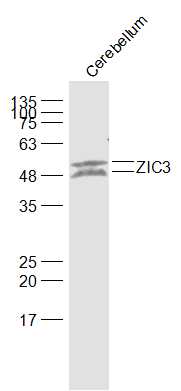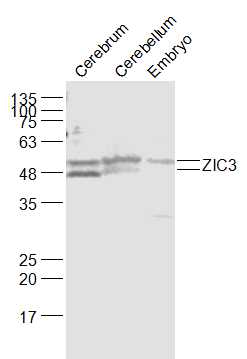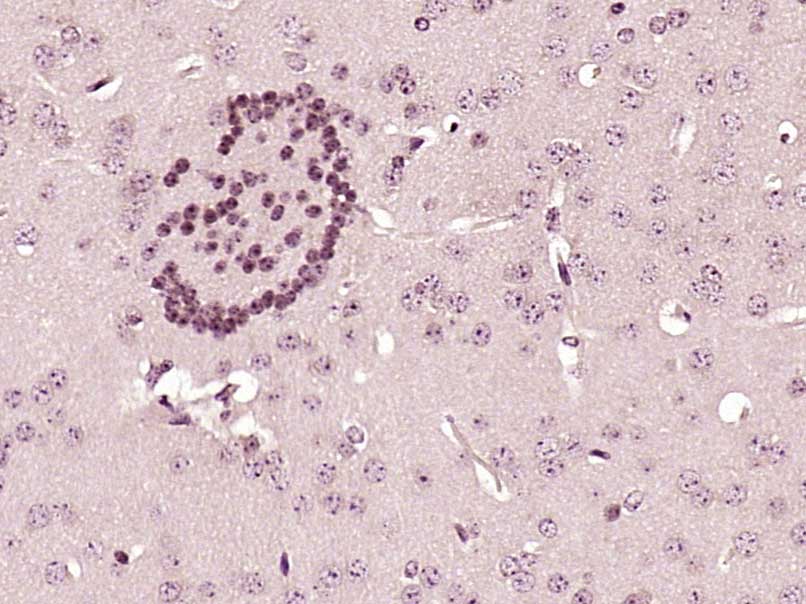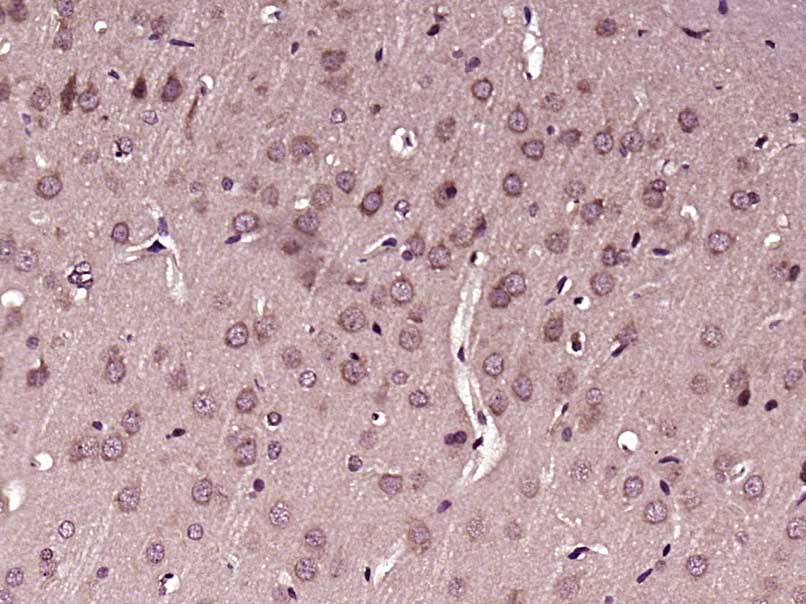
Rabbit Anti-ZIC3 antibody
Heterotaxy 1; HTX; HTX1; ZIC 3; Zic family member 3 (odd paired Drosophila homolog heterotaxy 1); Zic family member 3; Zic3; ZIC3_HUMAN; Zinc finger protein 203; Zinc finger protein of the cerebellum 3; Zinc finger protein ZIC 3 (Zinc finger protein of th
View History [Clear]
Details
Product Name ZIC3 Chinese Name 内脏异位相关蛋白/Zinc finger protein203抗体 Alias Heterotaxy 1; HTX; HTX1; ZIC 3; Zic family member 3 (odd paired Drosophila homolog heterotaxy 1); Zic family member 3; Zic3; ZIC3_HUMAN; Zinc finger protein 203; Zinc finger protein of the cerebellum 3; Zinc finger protein ZIC 3 (Zinc finger protein of the cerebellum 3); Zinc finger protein ZIC 3; ZNF203. literatures Research Area Cell biology Developmental biology Stem cells transcriptional regulatory factor Immunogen Species Rabbit Clonality Polyclonal React Species Mouse, Rat, (predicted: Human, Chicken, Dog, Pig, Cow, Sheep, ) Applications WB=1:500-2000 ELISA=1:5000-10000 IHC-P=1:100-500 IHC-F=1:100-500 ICC=1:100-500 IF=1:100-500 (Paraffin sections need antigen repair)
not yet tested in other applications.
optimal dilutions/concentrations should be determined by the end user.Theoretical molecular weight 51kDa Cellular localization The nucleus cytoplasmic Form Liquid Concentration 1mg/ml immunogen KLH conjugated synthetic peptide derived from human ZIC3: 331-410/467 Lsotype IgG Purification affinity purified by Protein A Buffer Solution 0.01M TBS(pH7.4) with 1% BSA, 0.03% Proclin300 and 50% Glycerol. Storage Shipped at 4℃. Store at -20 °C for one year. Avoid repeated freeze/thaw cycles. Attention This product as supplied is intended for research use only, not for use in human, therapeutic or diagnostic applications. PubMed PubMed Product Detail Zic3 is a C2H2 zinc finger transcription factor that establishes a proper left-right axis and midline neural patterning during early development of the vertebrate embryo. Mutations in this gene cause X-linked visceral heterotaxy, which includes congenital heart disease and left-right axis defects in organs. Zic3 mutations in the zinc finger DNA binding domain and in the N-terminal domain result in loss of reporter gene transactivation, and mutations between amino acids 253-323 of the Zic3 protein causes aberrant cytoplasmic localization rather than the wild type nuclear localization.
Function:
Acts as transcriptional activator. Required in the earliest stages in both axial midline development and left-right (LR) asymmetry specification. Binds to the minimal GLI-consensus sequence 5'-GGGTGGTC-3'.
Subcellular Location:
Nucleus. Cytoplasm. Localizes in the cytoplasm in presence of MDFIC overexpression (By similarity). Translocation to the nucleus requires KPNA1 or KPNA6.
DISEASE:
Defects in ZIC3 are the cause of visceral heterotaxy X-linked type 1 (HTX1) [MIM:306955]. A form of visceral heterotaxy, a complex disorder due to disruption of the normal left-right asymmetry of the thoracoabdominal organs. It results in an abnormal arrangement of visceral organs, and a wide variety of congenital defects. Clinical features of visceral heterotaxy X-linked type 1 include dextrocardia, corrected transposition of great arteries, ventricular septal defect, patent ductus arteriosus, pulmonic stenosis, situs inversus viscerum, and asplenia and/or polysplenia.
Defects in ZIC3 are a cause of VACTERL association X-linked with or without hydrocephalus (VACTERLX) [MIM:314390]. A syndrome characterized by vertebral anomalies, anal atresia, cardiac malformations, tracheoesophageal fistula, renal anomalies (urethral atresia with hydronephrosis), and limb anomalies (hexadactyly, humeral hypoplasia, radial aplasia, and proximally placed thumb). Some patients may have hydrocephalus. Some cases of VACTERL-H are associated with increased chromosome breakage and rearrangement.
Similarity:
Belongs to the GLI C2H2-type zinc-finger protein family.
Contains 5 C2H2-type zinc fingers.
SWISS:
O60481
Gene ID:
7547
Database links:Entrez Gene: 7547 Human
Entrez Gene: 22773 Mouse
Omim: 300265 Human
SwissProt: O60481 Human
SwissProt: Q62521 Mouse
Unigene: 111227 Human
Unigene: 255890 Mouse
Product Picture
Cerebellum (Rat) Lysate at 40 ug
Primary: Anti-ZIC3 (SL11608R) at 1/1000 dilution
Secondary: IRDye800CW Goat Anti-Rabbit IgG at 1/20000 dilution
Predicted band size: 51 kD
Observed band size: 49/50 kD
Sample:
Cerebrum (Mouse) Lysate at 40 ug
Cerebellum (Mouse) Lysate at 40 ug
Embryo (Mouse) Lysate at 40 ug
Primary: Anti-ZIC3 (SL11608R) at 1/1000 dilution
Secondary: IRDye800CW Goat Anti-Rabbit IgG at 1/20000 dilution
Predicted band size: 51 kD
Observed band size: 49/50 kD
Paraformaldehyde-fixed, paraffin embedded (Mouse brain); Antigen retrieval by boiling in sodium citrate buffer (pH6.0) for 15min; Block endogenous peroxidase by 3% hydrogen peroxide for 20 minutes; Blocking buffer (normal goat serum) at 37°C for 30min; Antibody incubation with (ZIC3) Polyclonal Antibody, Unconjugated (SL11608R) at 1:400 overnight at 4°C, followed by operating according to SP Kit(Rabbit) (sp-0023) instructionsand DAB staining.Paraformaldehyde-fixed, paraffin embedded (Rat brain); Antigen retrieval by boiling in sodium citrate buffer (pH6.0) for 15min; Block endogenous peroxidase by 3% hydrogen peroxide for 20 minutes; Blocking buffer (normal goat serum) at 37°C for 30min; Antibody incubation with (ZIC3) Polyclonal Antibody, Unconjugated (SL11608R) at 1:400 overnight at 4°C, followed by operating according to SP Kit(Rabbit) (sp-0023) instructionsand DAB staining.
Bought notes(bought amounts latest0)
No one bought this product
User Comment(Total0User Comment Num)
- No comment






 +86 571 56623320
+86 571 56623320
 +86 18668110335
+86 18668110335

